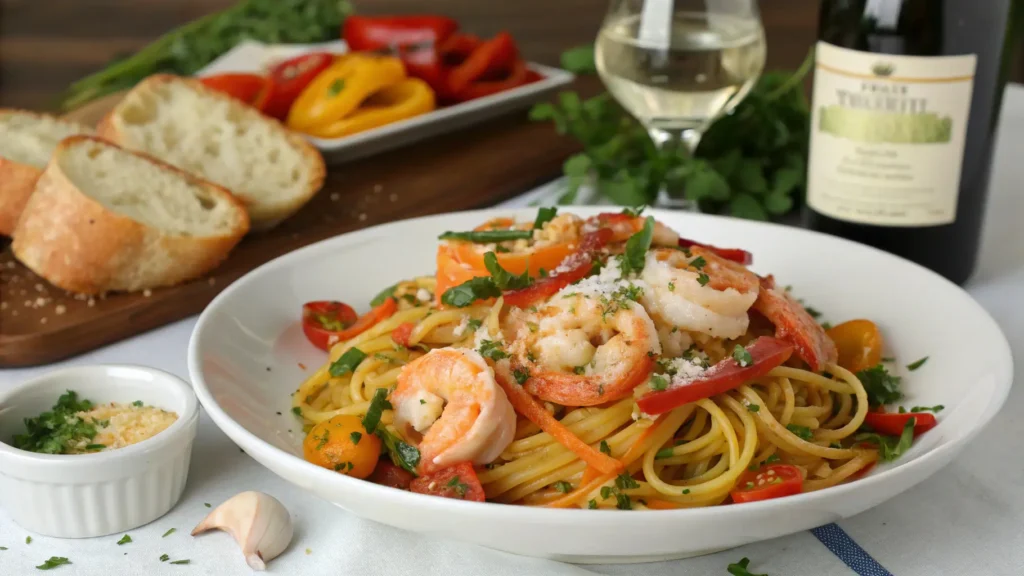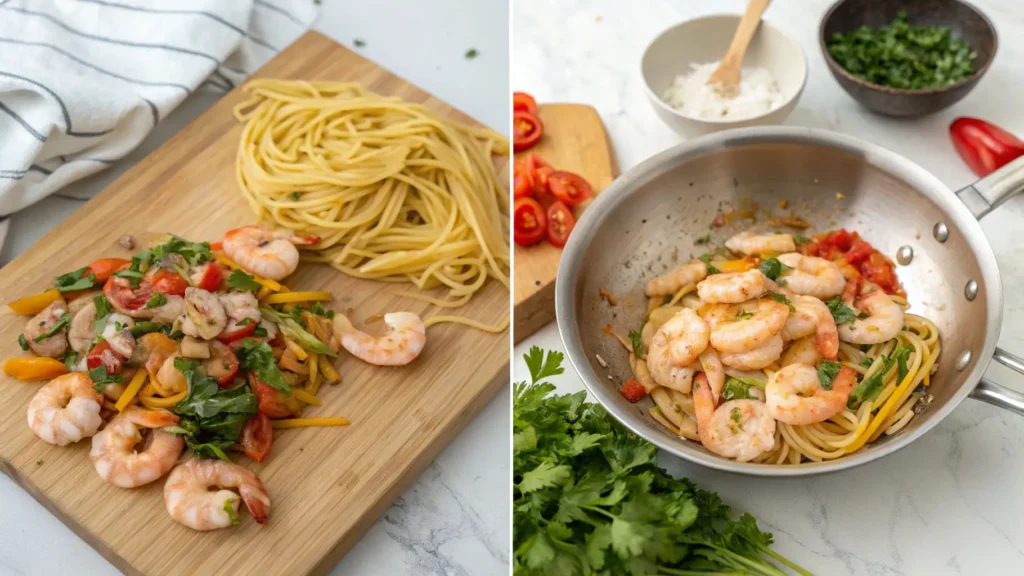Shrimp and veggie pasta is more than just a dish—it’s a delightful blend of wholesome goodness and rich flavors. This crowd-pleasing recipe combines succulent shrimp, fresh vegetables, and perfectly cooked pasta, making it a versatile meal option for any occasion. Whether you’re whipping it up for a weeknight dinner or showcasing your culinary skills for guests, this dish delivers on taste and nutrition.

In this article, we’ll explore everything from the ingredients and step-by-step preparation to tasty variations and expert tips for avoiding common mistakes. By the end, you’ll be equipped to create a dish that’s not only healthy but also bursting with flavor. Let’s dive in!
Introduction to Shrimp and Veggie Pasta
The Appeal of Shrimp and Veggie Pasta
What makes shrimp and veggie pasta so irresistible? It’s the harmony of textures and flavors that leaves a lasting impression. The juicy shrimp, crunchy veggies, and tender pasta come together with rich, aromatic sauces to create a dish that feels both indulgent and balanced.
This meal is incredibly adaptable. You can swap in different vegetables or experiment with sauces, making it a go-to recipe for clearing out your fridge while still feeling fancy.
Health Benefits of Shrimp and Vegetables
Not only is shrimp and veggie pasta delicious, but it’s also packed with health perks. Shrimp is a low-calorie, protein-rich option that’s high in essential nutrients like selenium and vitamin B12. Pair that with colorful vegetables—loaded with fiber, antioxidants, and vitamins—and you’ve got a nutritious powerhouse on your plate.
When paired with whole-grain or gluten-free pasta, this dish becomes a meal that checks all the boxes for a balanced diet. Plus, it’s a sneaky way to get kids (and adults!) to eat more veggies.
With these benefits in mind, it’s no wonder shrimp and veggie pasta is a favorite for many home cooks. Stay tuned as we delve into the essentials to create this culinary masterpiece!
Essential Ingredients for Shrimp and Veggie Pasta
Core Ingredients
Every great dish starts with the right ingredients, and shrimp and veggie pasta is no exception. To create this flavorful meal, you’ll need a handful of simple yet versatile components.
First, let’s talk about the star of the show: shrimp. Whether you prefer fresh or frozen, ensure the shrimp are peeled and deveined for easy cooking. Opt for large or jumbo shrimp to add a meaty texture to your pasta. If you’re feeling adventurous, marinate the shrimp with garlic, olive oil, and a splash of lemon juice for extra zest.
As for the pasta, the choice is yours! Classics like spaghetti, penne, or bowtie pasta work beautifully. Whole-grain or gluten-free options add a healthier twist without compromising flavor. Pro tip: Cook the pasta al dente, so it holds up well when tossed with the sauce and veggies.
Vegetables for Flavor and Nutrition
What makes shrimp and veggie pasta so appealing is the colorful medley of fresh vegetables. Zucchini, bell peppers, cherry tomatoes, and spinach are popular choices, each contributing its unique taste and texture. Don’t hesitate to switch things up with mushrooms, broccoli, or asparagus, depending on what’s in season.
Chopping your veggies uniformly ensures even cooking. For a balanced flavor, sauté them lightly to preserve their natural crunch and vibrant colors. This step is key to giving your pasta that signature restaurant-quality look and taste.
Sauces and Seasonings
The sauce ties everything together in shrimp and veggie pasta. A light lemon garlic sauce is a classic choice, offering a bright, zesty kick. For something richer, consider a creamy Parmesan-based sauce or even a tomato basil option.
Seasonings like salt, pepper, paprika, and Italian herbs elevate the flavor profile. Don’t forget a sprinkle of red pepper flakes if you’re craving a bit of heat. Finally, a generous garnish of freshly grated Parmesan and chopped parsley seals the deal for a truly mouthwatering finish.
Step-by-Step Guide to Making Shrimp and Veggie Pasta

Preparation of Ingredients
The key to a smooth cooking process is prepping your ingredients beforehand. Begin by cleaning the shrimp—rinsing them under cold water and patting them dry with a paper towel. If you haven’t already, marinate the shrimp with olive oil, minced garlic, and a dash of lemon juice.
Next, focus on your vegetables. Wash them thoroughly and cut them into bite-sized pieces. Remember, consistency is key for even cooking. While you’re at it, boil your pasta in salted water, making sure to reserve a cup of the starchy pasta water for later.
Cooking the Dish
Start by heating a large skillet over medium heat. Add a drizzle of olive oil, followed by the shrimp. Cook them until they turn pink and opaque—this usually takes about 2-3 minutes per side. Remove the shrimp and set them aside.
In the same skillet, toss in your veggies. Sauté them for 4-5 minutes, stirring occasionally, until they’re tender but still slightly crisp. Add minced garlic and let it cook for another minute to release its aroma.
Now, it’s time to bring everything together. Return the shrimp to the skillet and add your cooked pasta. Pour in the reserved pasta water and your chosen sauce. Toss everything well, ensuring the sauce coats each strand of pasta evenly.
Final Touches
Before serving, taste and adjust the seasoning as needed. A dash of lemon juice brightens the flavors, while freshly cracked black pepper adds a subtle kick. Plate your shrimp and veggie pasta with a sprinkle of Parmesan and a sprig of parsley for a picture-perfect presentation.
This step-by-step process guarantees a dish that’s as delightful to the eyes as it is to the taste buds.
Variations and Customizations
Adding Proteins or Changing the Base
One of the best things about shrimp and veggie pasta is how easily it adapts to your preferences. Want to swap out the shrimp? Chicken, scallops, or even tofu can step in as delicious alternatives.
For a unique twist, consider switching the pasta base. Zucchini noodles or spaghetti squash make for a low-carb option that doesn’t skimp on taste. Whole-grain or legume-based pasta options are fantastic choices if you’re looking to up the fiber and protein content.
Spicing It Up
Sometimes a little kick is all you need to transform a dish. Add red pepper flakes, Cajun seasoning, or even a pinch of smoked paprika to give your shrimp and veggie pasta a bold, spicy edge.
If you’re feeling adventurous, experiment with international flavors like a Thai-inspired coconut curry sauce or a Mediterranean spin with olives, feta, and sun-dried tomatoes.
Vegetarian and Vegan Adaptations
To make this dish vegetarian, simply leave out the shrimp and amp up the veggies. Mushrooms or chickpeas can add heartiness and depth. For a vegan version, use plant-based pasta and creamy cashew or coconut milk sauces instead of cheese-based ones.
For more delicious recipes, check out our creamy shrimp pasta recipe.
Pairing Suggestions for Shrimp and Veggie Pasta

Side Dishes to Complement
Pairing your shrimp and veggie pasta with the right sides elevates the meal to a restaurant-quality experience. A crisp green salad dressed with a tangy vinaigrette adds freshness and crunch. Alternatively, a slice of warm, buttery garlic bread is perfect for mopping up any leftover sauce.
Wine and Beverage Pairings
For an indulgent pairing, serve your pasta with a chilled glass of white wine like Sauvignon Blanc or Pinot Grigio. These wines complement the light, citrusy notes often found in the sauce.
Non-alcoholic options can be just as refreshing! Try a sparkling water infused with lemon and mint or a lightly sweetened iced tea to balance the flavors of the dish.
Whether you’re entertaining guests or enjoying a quiet dinner at home, these pairings bring out the best in shrimp and veggie pasta.
Common Mistakes and How to Avoid Them
Overcooking Shrimp or Vegetables
One common pitfall when making shrimp and veggie pasta is overcooking the shrimp. Shrimp cooks quickly—usually just 2–3 minutes per side. Leaving it on the heat too long makes it rubbery and less appetizing. Keep an eye on the color; as soon as the shrimp turns pink and opaque, it’s ready to go.
Vegetables can also lose their charm if overcooked. Sauté them until they’re tender but still crisp. This retains their natural sweetness and vibrant colors, giving the dish a fresh, appetizing look. Remember, a quick stir-fry is all it takes to make your veggies shine!
Balancing Flavors
Another mistake is not balancing the flavors. With so many bold ingredients in shrimp and veggie pasta, it’s important to harmonize them. Too much garlic can overpower the dish, while excessive lemon might make it too tangy. Taste as you go and adjust the seasoning gradually.
If your pasta feels too dry, don’t panic! Reserve some pasta water when boiling the noodles. Adding a splash while mixing everything together creates a creamy, cohesive sauce without extra oil or cream.
Pasta Cooking Tips
Lastly, avoid mushy pasta at all costs. Always cook your pasta al dente—firm to the bite. It will absorb some of the sauce while maintaining its structure. And don’t forget to salt the boiling water generously; it’s your chance to infuse the pasta with flavor.
By steering clear of these common mistakes, you’ll ensure that your shrimp and veggie pasta turns out perfect every time.
FAQs About Shrimp and Veggie Pasta
What’s the Best Pasta for This Dish?
The beauty of shrimp and veggie pasta is its versatility. Spaghetti, penne, or bowtie pasta all work wonderfully. If you prefer a heartier option, whole-grain or chickpea pasta adds extra nutrients. Looking for low-carb? Zucchini noodles are a fantastic alternative.
Can I Use Frozen Shrimp or Vegetables?
Absolutely! Frozen shrimp and veggies are convenient and just as nutritious as fresh ones. Thaw shrimp in cold water before cooking, and add frozen veggies directly to the pan—they’ll thaw as they cook.
How Can I Make This Meal Meal-Prep Friendly?
Shrimp and veggie pasta is great for meal prepping! Cook the pasta and mix it with olive oil to prevent sticking. Keep the shrimp and veggies in separate containers to maintain their texture. When ready to eat, combine and heat everything together for a quick and satisfying meal.
What Are Some Low-Carb Pasta Options?
Low-carb pasta options like zucchini noodles, spaghetti squash, or shirataki noodles are excellent swaps. They pair perfectly with shrimp and veggies while keeping the meal light and healthy.
By addressing these FAQs, you’ll feel confident tackling this dish, whether you’re a beginner or a seasoned cook.
Conclusion: Why Shrimp and Veggie Pasta Should Be Your Go-To Meal
A Versatile, Crowd-Pleasing Dish
At the heart of its charm, shrimp and veggie pasta is a dish that fits any occasion. Need a quick weeknight dinner? This recipe comes together in under 30 minutes. Hosting friends or family? Its vibrant colors and bold flavors make it an impressive crowd-pleaser.
The dish’s versatility doesn’t stop there. Whether you’re accommodating dietary preferences or experimenting with seasonal ingredients, this pasta is endlessly customizable. It’s the perfect blank canvas for your creativity, letting you tailor it to suit your taste buds or pantry staples.
Encouraging Creativity in the Kitchen
Cooking shrimp and veggie pasta is more than just following a recipe—it’s about enjoying the process. From choosing your vegetables to crafting the sauce, every step offers an opportunity to play with flavors and textures. Plus, the simplicity of the dish allows even beginner cooks to feel confident and accomplished in the kitchen.
Whether you stick with a classic garlic lemon sauce or venture into spicy Cajun or creamy Alfredo territory, the result is always a comforting, flavorful meal. And as you make it your own, you’ll discover how this dish can evolve into something uniquely yours.
So, the next time you’re searching for a quick, healthy, and delicious meal, reach for shrimp and veggie pasta. It’s more than a recipe—it’s an invitation to enjoy cooking and create something truly delightful.

